Terebess
fűszerkalauz
«
vissza a Terebess Online nyitólapjára
«
vissza a Kertek
és konyhák indexlapra
Vietnami szószok, levélfűszerek
A vietnami konyha laktató és változatos. Leginkább az különbözteti meg a kínai konyhától, hogy a fogásokat nem öntik nyakon szósszal, hanem a közös tálból pálcikákkal kiküzdött falatot magunknak kell belemártani a külön felszolgált öntetekbe.
Minden étkezés levessel (pho) kezdődik, ezután sertés-, marha-, csirke -és vadhúsból, csigából, halból és tenger gyümölcseiből választott második fogás jön, zöldségkörettel és rizzsel. Baguette-rajongók örülhetnek, mert a francia gyarmatosítóknak köszönhetően ez a francia kenyértípus Vietnamban is ismert. Végezetül zöld teát és gyümölcsöket (banán, mandarin, papaja) kapunk.
Vietnamban
fő táplálék a rizs, amelynek sok fajtáját használják - természetesen nem késsel-villával,
hanem evőpálcikával. Sok vízinövényt is felhasználnak levesek és főzelékek készítésére
és a különféle édesvízi- és tengeri halak, békák, csigák, rákok is megtalálhatók
az étlapokon. A vietnamiak sok fűszert és illatos növényeket használnak. Ezek
közül legelterjedtebb az erjesztett hallé (nuoc mam), amelyet pici tengeri halakból
erjesztéssel, nagyüzemi módon állítanak elő. Szaga az európai orr számára furcsa,
íze azonban már kellemes, ráadásul sok foszfor található benne, ami fontos a szervezetnek.
Az európaiak számára sokszor okoznak megbotránkozást a különböző, kutyából készülő
specialitások.
http://deluxe.hu/cikk.php?article=311


•
Au
trang; cây au (kétszarvú
sulyom) - Trapa bicornis
>>>Tovább
ling-kuo [kínai]
•
Banh phong tom (rákszirom)
prawn
crackers, shrimp chips
Szárított, rózsaszínes darált rákból, tápióka keményítőből
és tojásfehérjéből készül. Önmagában rágcsálják, vagy salátához adják.



•
Ca cuong (indiai tutajpoloska) - Lethocerus
indicus Lep. & Serv. (= Belostoma indica Vitalis)
giant water beetle [angol],
punaise d'eau géante [francia], kepik air [indonéz], maeng-da, maengda-na [thai]
A
tutajpoloska gorgonzola-sajt ízű potroh-nedve fűszerként mártogatós szószokba
használatos. Kevés kell belőle, ritkasága miatt egyre drágább, ezért hamisítják
is. Magát a bogarat is megeszik. 6-8 cm nagy, tavak, folyóvizek elárasztott rizsföldek
ragadozója.
További fotók: http://plaza.rakuten.co.jp/lethocerus/diary/?ctgy=1
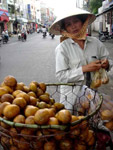

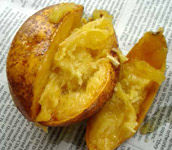
• Coc; trái cóc - Spondias
dulcis (Spondias cytherea)
Amberella, Java plum, Great hog plum, Otaheite apple,
marapa, acaiba, mopé, kedondong, kook hvan, hevi, ma-kok-farang, caja-manga, jobo
de Indio
A mangóhoz hasonló gyümölcs, de savanykásabb.
Zsenge, savanykás leveleit főleg frissen, nyersen fogyasztják.
•
Dau pho
(đau hu)
tofu, szójasajt, babtúró
doufu [kínai], tôfu [japán], tauhu [thai,
maláj] tahu [indonéz], dubu [koreai], tokwa [filippínó]
•
Dau me (szezámolaj)
Dús aromájú, borostyánszínű olaj,
pirított szezámmagból sajtolják. Csak néhány csepp kell belőle a pácokhoz vagy
a főzés végén bizonyos fogásokhoz.

• Dau
rong, szárnyasbab
- Psophocarpus tetragonolobus >>>Tovább
Winged
Beans (Đau Rong)
•
Fekete ecet
black vinegar
Sötét,
édeskés ízű (az olasz balzsamecetre emlékeztető) gyenge ecet. Ragacsos rizsből
vagy szemescirokból erjesztik.
•
Fokhagymás olaj
Sok vietnami ételhez
használják: tésztaleveshez, grillezett húsokhoz, zöldséghez, kenyérhez. Hozzávalók:
3 dl földimogyoró-olaj
6 gerezd tört fokhagyma
Forrósítsunk olajat, de ne füstölésig (kb. 150 fokra). Húzzuk le a tűzről és dobjuk bele a fokhagymát. Hagyjuk így lehűlni szobahőmérsékletre. Jól záródó edényben egy hétig eltartható.

• Hot vit lon, kacsaembrió
balut
[filippínó], maodan [kínai]
19-21 napos félig kialakult embrió, főzve fogyasztják
(a Fülöp-szigeteken a 17 napost kedvelik)
Ebben a korban az embriónak már látható
a feje, a szárnyai, kivehető a csontozata, sőt már tolla is akad. A tojásokat
lámpa alatt keltetik, majd megfőzik, melegen tartják, az éhes vásárló pedig ecetes-olajos
szószba mártogatja, és egy kis sóval már fogyasztja is a tojásból.
•
Mam
nem
fermentált
ajókaszósz, fermented anchovy dip
Hozzávalók:
2 ek fermentált ajókaszósz vagy paszta
fél csésze víz
2 teáskanál fekete ecet
2 ek szétnyomkodott ananász
1/4 szál ázsiai citromfű, finomra vágva
1 piros csiliparika, finomra vágva
1 gerezd fokhagyma, tört
1 teáskanál cukor
csipet bors
Csak össze kell alaposan keverni.
•
Mam
ruoc, rákpaszta
A "ruoc" apró garnélafajta,
amit csak az esős évszakban halásznak. Először megpucolják, majd napon szárítják
három hónapig. Ezután sóval keverik, porrá őrlik és kerámia bödönben újabb 45
napig napra teszik. Végül cukrot adnak hozzá és 30 napig erjesztik, majd kiteszik
a napra száradni újabb 10 napra. Ilyen egyszerű.
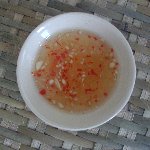

• Nuoc
cham (mártogatós szósz)
Hozzávalók:
1-2 gerezd fokhagyma
1 piros csilipaprika, kimagozva
2 teáskanál cukor
egy negyed zöldcitrom
két és fél evőkanál víz
2 evőkanál nuoc mam halszósz
Mozsárban péppé törik a fokhagymát, a csilit és a cukrot. Belecsavarják a zöldcitrom levét, majd késsel leszedik a húsát és azt is hozzáadják. Végül jól elkeverik a vízzel és a halszósszal.
Cha ca (hanoi halrecept nuoc cham szósszal)
http://buvosszakacs.blog.hu/2008/02/14/cha_ca_hanoi_halreceptFinomra reszelt friss sárgarépát is tesznek a nuoc cham szószba, ha tavaszi tekercs (délen: cha gio, északon: nem ran) mártogatásához kell.
http://chiliesvanilia.blogspot.com/2006/05/nem-saigon-de-saigon-cha-gio.html [magyarul!]
Mártogatós vietnami szósz tavaszi tekercshez, amit salátalevélbe tekernek, mentalevéllel, korianderzölddel, uborkával együtt:
2 dl sárgarépalé
1 dl vietnami halszósz (nuoc mam)
0,5 dl barna rizsecet
fél citrom leve
kis diónyi gyömbér
4 gerezd fokhagyma
•
Nuoc
leo, mogyorószósz
1/4 csésze pörkölt földimogyoró, nem sózott, darálva
1 evőkanál földimogyoró olaj
2 gerezd fokhagyma, apróra vágva
1 teáskanál csilipaszta (tuong ot tuoi)
2 evőkanál paradicsompüré
1/2 csésze tyúkleves vagy víz
1/2 teáskanál cukor
1 evőkanál mogyoróvaj
1/4 csésze hoisin-szósz
1 friss csöves csilipaprika, magháza nélkül, felszeletelve
Tavaszi tekercshez adják, reszelt sárgarépával és halszósszal.
Olajat
forrósítanak egy serpenyőben, hozzáadják a fokhagymát, a csilipasztát és a paradicsompürét.
Fél percig pirítják, majd beleöntik a tyúklevest, hoisin-szószt, mogyoróvajat,
cukrot. Keverni kell forrásig, majd kis lángon párolni 3 percig.
Külön szószos
tálkákba osztják szét, darált mogyoróval, csili karikákkal díszítik. Melegen vagy
szobahőmérsékleten tálalják.




• Nuoc
mam, halszósz
A
vietnami konyha legalapvetőbb ízesítője, só illetve szójaszósz helyett is többnyire
ezt használják. Szinte minden receptükben előfordul.
Hatalmas
fahordókban apró, nagyon friss halakat (ajókát és egyebet) rétegeznek sóval (10:4
arányban), három hónapi érlelés után a hordó nyitott csapján megindult kicsorgó
levet vissza-visszaöntik a tetejére, végül 6-12 hónap múltán végleg lecsapolják
az elkészült szószt. Ezután már cserépedényekben tárolják.
A
legjobb minőséget (mint az extra szűz olívaolajnál) az első csapolás adja: világosabb
színű, tisztán áttetsző folyadék. Ezt adják fel az asztalra. A második-harmadik
szüret kevésbé jó, általában a főzésnél használják. A gyártás két legfontosabb
központja Phu Quoc és Phan Thiet. Phu Quoc-ban készül a csúcsminőség. A címkén
a "nhi" szó a kiváló minőséget, azt pedig, hogy kizárólag ajókából készült
(ez a legjobb!) a "Ca Com" jelöli.
Délkelet-Ázsia több országában is készítenek hasonlóan fermentált halszószt: nam pla (thai), prahok (khmer), patis (filippínó), nam pa (laoszi; padek = kizárólag édesvízi halból készül), ngan-pya-ye (burmai), yulu (kínai, maláj), kecap ikan (indonéz), yeotgal (koreai), shottsuru, ishiru, ikanago-jôyu (japán), de a régi római halmártás, a garum vagy liquamen se lehetett nagyon más (az oxygarum ecettel, a meligarum mézzel készült), ami helyett nyugaton manapság nem-fermentált szardellapasztát vagy ringlit használunk.
•
Nuoc tuong, szójaszósz
xi dau,
tuong
Hagyományos világosbarna szósz, darált szójababból készül vízzel, pirított
rizsliszttel és sóval.

• Pho
(ejtsd: fő) leves
http://kispad.hu/bilagit/200608/a-szurcsoles-muveszete-pho.html
http://buvosszakacs.blog.hu/2007/09/02/ph_bo_leves
http://www.noltv.hu/video/3122.html
• Tan
xai (savanyított zöldség)
A mi savanyú káposztánkhoz, a koreai kimchi-hez, a kínai zhacai-hoz,
a japán tsukemono-hoz hasonló: sóban, tejsavas erjesztéssel, fűszerekkkel
eltett kínai kel és egyéb zöldség. Erős.
Cai chua - Ngot cai xay
sós-cukros-ecetes mustárzöld kurkumagyökér-szeletekkel, fűszerek, fokhagyma,Pickled Mustard Greens (Dua Cai Chua)
http://trucvy-zoe.blogspot.com/2009/03/pickled-mustard-greens-dua-cai-chua.html

• Thảo quả - Lanxangia tsaoko, formerly Amomum tsao-ko
fekete kardamom
A fekete kardamom ízvilága egészen egyedi. Ugyan a neve kardamom, de semmi köze a zöld kardamomhoz, ez egy egészen más növény magja, és ezt nem használják szinte soha édességekben. Íze kissé füstös, köszönhetően a nyílt láng fölötti szárításnak. Főleg a Himalájában termesztik. Vietnámban kedvelt fűszer, a pho leves kihagyhatatlan ízesítője.
At least two distinct species of black cardamom occur: Amomum subulatum (also known as Nepal cardamom) and Amomum tsao-ko which is a ginger-like plant known in English by the transliterated Chinese name (Chinese: 草果; pinyin: cǎoguǒ). It grows at high altitudes in Yunnan, as well as the northern highlands of Vietnam. Both wild and cultivated plants are used medicinally and also in cooking. The dried fruit of the plant has a punguent, gingery taste.

• Thi
nhum - Diospyros pilosanthera
•
Tuong
đen
(= feketeszósz),
hoiszinszósz
hoisin
sauce, Chinese barbecue sauce, suckling pig sauce [angol]
Mártogatós
szósz, fermentált szójababból, szárított csilipaprikából, fokhagymából, ecetből,
cukor, só és fűszerek hozzáadásával készül.

•
Tuong ot (csiliszósz)
lak
kiu chuong, nuoc tuong ot
Csípős szósz frissen darált csöves csiliből, fokhagymával,
sóval, cukorral és ecettel. Asztali ízesítőként szolgál, de pl. levesekbe, zöld
papaja salátához is jó.


•
Tuong ot toi (csili paszta)
ot
toi
Sóval és szójaolajjal összezúzott friss piros csilipaprika és fokhagyma.
Sriracha csiliszósz, Sriracha hot chili sauce (tuong ot sriracha, tuong ot an pho)
Összetevők: csilipaprika, cukor, fokhagyma, só, ecet. Olyan, mint egy fűszeres ketchup. Főleg asztali fűszerként használják.
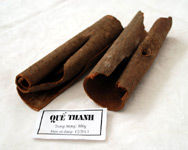

• Vietnami fahéj
- Cinnamomum loureirii Nees.
Que, Que qui, Que tanh hoa, Saigon fahéj, Vietnamese cinnamon
Ezt a rosszabb minőségű fahéjat régen a kelet-európai szocialista országokba
szállították. Ma már csak Vietnamban használják.
Cây que (C. zeylanicum) - Cinnamomum verum J. Presl.
Long nao - Cinnamomum camphora (L.) Presl.
Que - Cinnamomum cassia auct. / Cinnamomum aromaticum Nees
•
Vietnami
páclé
szárnyasokhoz, sertéshez, a tenger gyümölcseihez
2 gerezd tört fokhagyma
3 salottahagyma felaprítva
1/4 csésze földimogyoró-olaj
3 ek nuoc mam szósz
2 ek cukor
1/4 tk húslevespor
1/4 tk frissen őrölt feketebors
•
Vietnami
savanyúság
Hozzávalók:
1 kg jégcsapretek
1 nagyobb sárgarépa
2 ek só
5 ek cukor
1 csésze ecet
Hámozzuk
meg mindkét gyökér zöldséget, vágjuk vékony szeletekre vagy pálcikákra.
Keverjük
össze a sóval és pihentessük 5 percig, majd jól öblítsük ki.
Olvasszuk fel
a cukrot az ecetben és marináljuk benne a zöldséget egy óra hosszáig tálalás előtt.
Elkészíthető
előre, hűtőben eláll egy hétig.
Tavaszi tekercshez, grillezett húsokhoz adják
fel.
Rau
thom
Vietnami
levélfűszerek


A
vietnami friss zöld levélfűszerek gyűjtőneve: rau thom = "illatos levelek".
A "rau răm" kivételével a rau (levél) előtag elhagyható a köznapi
beszédben a zöldfűszer nevéből.

• He - Allium tuberosum
kínai metélőhagyma, enyhén fokhagymaízű


• Ngo, mui - Coriandrum sativum L.
korianderzöld, cilantro, kínai petrezselyem, cigánypetrezselyem
Az ételhez a főzés végén adják, de szinte elengedhetetlen része az asztali zöldsalátás tálnak. A kifejlett leveleket és a zsenge új hajtásokat is fogyasztják sült húsokhoz, halakhoz, zöldségekhez. Hamar fonnyad, mindig frissen használjuk.
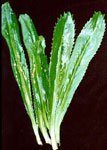

• Ngo gai, mui tau, ngo tau, cây ngo tau - Eryngium foetidum
Mexican coriander, thorny coriander, culantro, saw-leaf herb, saw-tooth herb, recao, Tabasco parsley
Kissé drágább a többi zöldfűszernél, mert lassan nő, jól bírja a forróságot. Minden egyes vastag, lándzsás levelét tőből hajtja ki, nem növeszt szárat. "Tüskéi" ártalmatlanok. Erősebb zamatú, mint az igazi korianderzöld, zamatát főzés után is megőrzi.
Metélt leveleivel a tésztalevest (pho) is megszórják. Dél-Amerikából származik, de ma már Délkelet-Ázsia szerte elterjedt.


• Rau răm - Polygonum odoratum Lour., Persicaria odorata
Vietnami "koriander", Szingapúrban laksa levélnek hívják. Mindig friss zöldként fogyasztják, leginkább a koriander szagára emlékeztet, citromos beütéssel, csípősség nem jellemző rá, mint a rokon borsos keserűfűre (vízibors, Water pepper - Polygonum hydropiper L.).
Évelő, kisebb fagyokat is elvisel. Cserépben jól nevelhető, ha napos helyen tartjuk.
http://en.wikipedia.org/wiki/Vietnamese_Coriander

• Rau dang - Glinus oppositifolius, Glinus lotoides
Foo Yip, Bitter Leaf, Bitter Herb (Rau Đang)
Nagyon keserű, frissen mártogatós szószokba, levesbe teszik vagy kifőzik. Vízinövény, könnyen termeszthető, gyorsan nő.

• Bac ha - Mentha arvensis L.
japán menta
Az ázsiai trópusi fodormenta kereklevelű változata az egyik leggyakrabban használt vietnami zöldfűszer.
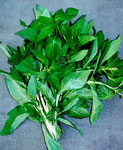
• Rau hung - Mentha x gracilis
hung lui, hung diu, hung lang
fodormenta, mint, spearmint
A vietnamiak kedvenc, leggyakrabban használt mentája.

Rau hung dui, peppermintCây bac ha -> Mentha arvensis L
Cây bac ha -> Mentha piperita L.
Cây bac ha hăng -> Mentha pulegium L.
Húng cây -> Mentha arvensis L. var. javanica (Bl.) Hook f.
Húng dui -> Mentha crispa L. -> Mentha spicata L.
Húng lá tron -> Mentha x rotundifolia (L.) Huds.
Húng lui -> Mentha aquatica L. var. aquatica
Rau hung dui -> Mentha cordifolia Opiz ex Fresen. -> Mentha spicata L.
Rau thom -> Mentha aquatica L.

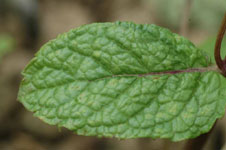
• Rau hung cay - Mentha spicata
zöldmenta, marokkói menta
Erőteljes borsos menta illata miatt nem használják olyan gyakran, mint finomabb aromájú rau hung-ot. Jól megy a marhahús leveshez.


• Hung que - Ocimum basilicum
rau que (Lá Que), thai bazsalikom, Thai purple basil, Asian basil, anise basil
Pho-leveshez, véreshurkához (long heo) föltétlen, meg amihez lehet, a leggyakoribb bazsalikom.Cây húng doi -> Ocimum basilicum L.
Cây húng que -> Ocimum basilicum L.
É trang -> Ocimum basilicum L.
Húng doi -> Ocimum basilicum L.
Húng gioi -> Ocimum basilicum L.
Húng hue -> Ocimum basilicum L.
Húng que -> Ocimum tenuiflorum L. -> Ocimum basilicum L.
Huong nhu -> Ocimum sanctum L. / Ocimum tenuiflorum L.
Huong nhu tía -> Ocimum sanctum L. / Ocimum tenuiflorum L.
Huong thao -> Ocimum americanum L. var. pilosum (Willd.) A. J. Paton
Rau que -> Ocimum tenuiflorum L.
Tra tien -> Ocimum americanum L. var. pilosum (Willd.) A. J. Paton


• Kinh gioi - Elsholtzia ciliata
fésűs szálkamenta, Vietnamese balm, Vietnamese mint, Crested Latesummer Mint (Xiang Ru)
A nálunk évelő dísznövényként ültetett kései szálkamenta (Elsholtzia stauntonii) rokona. Egynyári, levélfűszer, a tavaszi tekercs elmaradhatatlan kísérője. Levelei enyhén citromos aromájúak. Ősszel hozza levendulaszínű virágfüzéreit. Dugványokról szaporíthatjuk.


• Tia to - Perilla frutescens (L.) Britt.
feketecsalán, cserjésperilla-levél; beefsteakplant, purple or red perilla
A Vietnamban használt perilla-levél egyik fele lila, másik fele zöld (vagy mindkét felén bordó). Erőteljes zamata leginkább a fahéjra, ánizsra és igazi édesgyökérre emlékeztet.



• Ba om, ngo om - Limnophila aromatica [Lomk.] Merril
lang hom nay, mot vung rau, rau ngo, rau om,
rizsföldi citromfű, rice paddy herb
Vietnamban a vízzel elárasztott rizsföldeken termesztik. A trópusokon kívül igen nehéz nevelni, bár egy élő szár vízben, műanyag zacskó alatt egy-két hét alatt kigyökeresedik. Csak fokozatosan tegyük ki napfénynek, földjét keverjük égetett anyag golyócskákkal. Mindig tartsuk melegen és párásan.
Halványan citrom és enyhén kömény illatú, főleg savanyú hallevesekhez használják.
http://en.wikipedia.org/wiki/Limnophila_aromatica


• Diep ca, dap ca - Houttuynia cordata Thunb.
giap ca, vap ca, ngu tinh thao,
halpikkely menta, kaméleon menta, chameleon plant, fish mint
Szívalakú, friss zöld leveleit használják, de a rizómája is aromás. Kissé savanykásan halszagú, de sokan éppen ezt szeretik benne. Merész ízkombinációkban érvényesül, pl. erősen fűszerezett nyársonsült marhahúsnál. Vietnamon kívül nemigen kapható.
http://en.wikipedia.org/wiki/Houttuynia
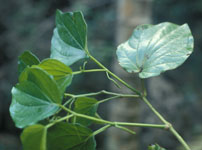

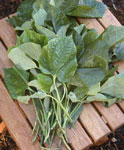
• La lot - Piper sarmentosum
borslevél, pepper leaf, wild betel leaf, ye-thoei (thai)
Szívalakú, kissé orvosságízű, nyersen édesen fahéjillatú levelei a fonákjukon hamvasak, a színükön fényesek, mintha nedvesek lennének. Kiválóak darált marhahúst töltésére. Grillezve újabb fűszeres aromák szabadulnak fel belőlük. (A leveleket abálják forró vízben, majd belecsavarják a húst, nyársra húzzák és úgy grillezik.). Kiváló szobanövény.
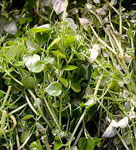
• Cang cua, rákollófű - Peperomia pellucida
Salad Pepperomia, Vietnamese Crab Claw Herb
Apró növény, apró, fényes, szív alakú levelekkel, salátának való. Gyorsan nő, kedveli az árnyékot.

• Can nuoc, vízipetrezselyem - Oenanthe javanica
water parsley


• Xa, ázsiai citromfű - Cymbopogon citratus [DC.] Stapf
lemongrass
Nincs vietnami konyha citromfű nélkül. Szerencsére hetekig eláll a hűtőben és a fagyasztást is bírja. Dézsában is nevelhető otthon, a friss citromfű földbe dugva kihajt.



• Rau chua, rau thom, sóska - Rumex acetosa L.
sorrel [angol], oseille [francia]
A sóska felhasználása a friss zöld levélfűszerek között a viet-amerikaiak asztalánál terjedt el. Ezért nincs igazi vietnami neve sem, a rau chua savanyú füvet, a rau thom friss füvet jelent. A sóska nyersen tavasszal a legfinomabb, mint mi is tudjuk gyerekkorunkból. A tavaszi tekercs töltelékében néha ezzel helyettesítik a karambola (csillaggyümölcs) szeleteket.


• Rau bo ngot - Sauropus androgynus
Bu Ngot, Bo Ngot; Sweet leaf bush
Shrub 1-3m, with short branches 7-12 cm. Leaves 7 x 3 cm, dark green, used in soup. Female Flower dark red. Fruit is white, on red sepals, having 4-5 seeds. Young leaves used in soup. The leaves and the top 15 cm of stem tips of the Sauropus plant have a pleasant taste, similar to fresh garden peas, and slightly nutty and are normally eaten raw in salads or steamed, to add to stir-fry, rice and egg dishes, soups or casseroles. The leaves retain their dark green colour and firm texture on cooking and are served in restaurants as "sayor manis". The flowers and small purplish fruits of the plant have also be eaten.

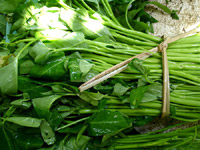


• Rau muong, rau muong che - Ipomoea reptans, Ipomoea aquatica
víziparaj, water spinach
Kang-Kong, (Đau Đua)
Water spinach is an herbaceous aquatic or semi-aquatic perennial plant of the tropics and subtropics. It has a creeping growth habit but may grow erect in water. This cultivar is Ching Quat, also known as “green stem” water spinach, has long leaves and white flowers and is usually grown in moist soils. (Pak Quat, also known as “white stem” water spinach, has arrow-shaped leaves and pink flowers and is grown in aquatic conditions, similar to rice). Almost all parts of the young plant tissue are edible, but the tender shoot tips and younger leaves are preferred.
http://www.asiafood.org/glossary_1.cfm?alpha=W&wordid=3322&startno=1&endno=25 szöveg
szálakra szedett víziparaj
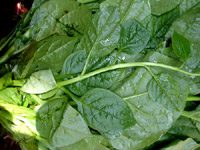
• Mong toi (Saan Choy) - Basella rubra, Basella rubra var. rubra
Ceylon Spinach, Vine Spinach, Malabar Spinach
This tropical spinach is highly nutritious, easy to grow, and decorative. Does not bolt even under extreme July heat. The vine has bright purple color with green succulent leaves. Well-fertilized vines produce palm-sized leaves throughout summer for use in salad or soup.
• Rau day
• Banánvirág forgács
Külső
linkek:
http://www.floraexotica.ca/Vegie.htm
http://floraexotica.ca/Fruit.htm
http://www.plantnames.unimelb.edu.au/Sorting/Vietnamese_index.html
http://www.noodlepie.com/
http://www.geocities.jp/vietnam_shokuzai_zuten/
http://vietworldkitchen.com/essentials/herbs.htm
http://vi.wikipedia.org/wiki/Chi_H%C3%BAng
http://en.wikipedia.org/wiki/Vietnamese_cuisine
További
info ![]()
Ginkgo Biloba (Bach Qua, Pak-wa) - Attractive fan-shaped leaves densely cover branches of this pre-historic tree, the few species survived since the dinosaur age. Excellent for Bonsai. Fruit contains pac-kwa, a delicacy in the Orient.
Lotus (Hoa Sen, Lien Hoa)
Pandan
Plant (Lá Dua) - Pandanus Amaryllifolius, Pandanus
Odorus, Pandanus odoratissimus
This
plant has a very nice scent. It is widely used in South Asia to give scent to
sweet rice and other desert dishes. Before cooking, just add one leave to your
steamed rice and the rice will become fragrant, even more fragrant than jasmin
rice!
Okra
(Đau Bap) - Abelmoschus esculentus, Hibiscus esculentus
This
plant grows to 5 feet high, producing pretty yellow flowers resembling a hibiscus
flower. Crunchy fruits are used fresh or cooked in many dishes.
Red
variety has red stem and unusual red fruits!
Stevia,
Sugar Leaf (Rau Ngot) - Stevia rebaudiana
A super-sweet herb that is hundred
times sweeter than sugar with no calories ! A native perennial from Paraguay,
the leaves of this herbs have been used as a natural sweetener there for centuries.
Widely used in food industry in Brazil and Japan to sweeten sodas and baked goods.
Grape
Tomato (Ca Nho)
New variety with superior taste and thin skin, thick flesh,
much better than cherry tomatoes.
Asparagus
Bean, String Bean (Đau Đua) - Vigna unguiculata var sesquipedalis
Very popular
in Oriental cuisine, this vegetable produce stringless 1-foot long beans that
dangle on the vine like pairs of chopsticks. Large violet flowers. Excellent for
salad, stir-fried, or Thai curry dishes. Try this beautiful crop in your garden
this year!
Bitter
Melon, Foo Gwa (Kho Qua) - Momordica charantia
The vine is very decorative
with bright green serrated leaves and numerous yellow, scented flowers. The melon
has an interesting look, about 6 to 12 inches long, with a bitter taste that can
be reduced when preparing.
Fuzzy
Squash (Bí Đao Chanh) - Benincasia hispida
Fast-growing vine with orange-yellow
flowers followed by edible fruits. Used in soup and stir-fried.
Winter
Melon - Benincasia 'Winter'
Fast-growing vine with giant fruits. Used in soup
and in making candies.
Lufa
(Muop Khía) - Luffa acutangula
Vine with dark green leaves and yellow flower.
Fruits have White, fragrant flesh, used in stir-fried dishes or soup.
Bottle
Gourd, Ornamental Gourd (Bau Nam, Bau Ho Lô) -
Lagenaria siceraria
This
fast-growing vine can quickly cover a trellis or any structure you want to hide
(an unsightly wall, storage shed). At the end of the season, you will be rewarded
with decorative gourds dangling on the vine. This gourd is expensive and not usually
found even in Oriental markets. Delicious in stir-fried dishes, soup, or steamed.
Ipomoea
batatas (Rau Lang, Đot Lang)
This sweet-potato vine produce abundance of new
growth and young leaves for cooking. This foliage is used (boiled or steamed)
in many countries. At the end of the season, dig out the sweet potatos for baking
or deep-fried.
Chili
Pepper, Piment (Ot Tí-hon)- Capsicum
These varieties are well suited for our
short summer. The red fruits are intensively hot. The super dwarf variety can
also be grown as a bonsai on your kitchen counter, a convenient living spice rack!
Amaranth
(Rau Den)- Amaranthus rubra
This colorful vegetable makes nice decorative plants
in your garden. Bright green leaves have contrasting red spots. Used steamed or
boiled.

Choy
(Cai Ngot)- T
Choy (Cai Trang)- T
Oyster
Herb, Oyster Plant, Boatlily (Cây Le Ban, Lao Ban, So Huyet)- Tradescantia discolor,
Rhaeo discolor
Leaves are sword-shaped, erect, dark green above and deep purple
underneath. Interesting flowers: small, white, three-petaled, crowded into boat-shaped
bracts borne down among leaves. Used as a medicinal herb in South Asia
Chopsuy Green, Vegetable Chrysanthemum (Tan-Ô, Cai Cúc) Aromatic leaf vegetable with pretty yellow flowers. Used fresh or in soup.
Egyptian
Walking Onion (Hanh Lá) - Allium cepa var. viviparum
The plant practically
'walks' around your garden after a few seasons. Extremely hardy and easy to grow,
this perennial provides your kitchen with green shallot from early April to October.
Very vigorous and trouble-free. Mature plants produce flower heads with baby bulbs
on 1-2 feet spikes. As the bulbs mature and gain weight, the spikes lean on the
ground, the bulbs then take root to start a new generation, a few feet away from
their parents.
Fish
Wort (Vap Cá)- Houttuynia cordata
Perennial herb hardy to zone 5. Nice heart-shaped
leaves are used fresh in salad and other dishes.
Chinese Chive, Garlic Chive, Gow Choy (He)- A hardy perennial chive with aroma more intensive than that of the regular chive. Very easy to grow. Clump-forming. Used fresh in salad, spring rolls, in stir-fried dishes or in soups. The taste is like a combination of leek, chives, and garlic.
Upright
Elephants Ears (Bac Ha) - Alocasia odora, Arum odorum
- An aquatic plant that
grows to 1 meter or more. The stalk (stem) is used in Tom-Yum soup or Tamarind
soup.
Gotu
Kola, Penny Wort (Rau Má) - Hydrocotyle asiatica
Leaf extract of this herb
is used as a refreshing drink. The herb is believed to have blood-purification
benefit.
Magenta
Plant (Lá Cam)- Peristrophe Roxburghiana
A tender perennial, this plant produces
magenta flowers in summer, and in winter if given lots of sunshine. The leaf extract
is used as a natural food coloring, giving a lovely magenta color to sweet rice
and other foods.
Cuban Oregano,
Jamaican Thyme, Broadlead Thyme (Can Day Lá) - Plectranthus amboinicus
This
aromatic tropical thyme is used in Oriental cuisine and tropical America. Its
taste is similar to that of Greek Oregano. Large fuzzy succulent leaves .
Variegated Cuban Oregano, Variegated Jamaican Thyme: Same herb, with variegated leaves! Very decorative! Makes a beautiful pot plant or a hanging basket. Grow it outside in summer, and bring inside in winter for a continuous supply of oregano.
Water Celery (Can Ong, Can Nuoc) - A hardy perennial herb with purple stem. Nice scent similar to celery. Used in stir-fry dishes with beef.
Trau
không - Piper betle L.
Betel Leaf, Bétel, Pan, Phulu (Lá Trau) - Piper betle
Evergreen
vine climbing to a height of 1m. Stem is slender, twining and rounded. Leaves
are oval-acuminate, green and smooth. Flowers are green, occurring in spikes.
Fruit are fleshy, red berries. The leaves are chewed together with mineral lime
and Betel nut as a stimulant an antiseptic and a breath freshener.
Viet gyümölcs
http://floraexotica.ca/Fruit.htm
Hardy Asian Pears (Le Tau, Le Nhat) - (Le Tau, Le Nhat) - Pyrus serotina The easiest tree fruit to grow outdoor. Very crisp, sweet, and juicy. It is an excellent ornamental tree. In Spring, the tree is covered with early white blossoms. The glossy attractive leaves are tinged with purple in late summer and autumn. Fruits store well, up to months after harvesting. Ready-to-eat right off the tree. Our trees are grafted on European-pear rootstock so that they can survive the winter in Canada. Shipped to Canada addresses only.
Buble-gum
Plant, Teaberry, Wintergreen, Petit the du bois -
Gaultheria procumbens -
Hardy
to zone 3, -34 C . A very interesting berry plant with 'buble-gum' aroma in its
fruits and leaves. Dark shiny green leaves, pinkish white flowers followed by
scarlet red berries that are pleasant-tasting and enjoyed by people and wildlife.
The plant is also known as Teaberry because American revolutionists used the fragrant
leaves as one of their tea substitutes while boycotting English tea! The leaves
also produces an essential oil used as flavor for chewing gum. Wintergreen oil
contains methyl salycliates, the active painkilllers of asprin.
Goji
Berry, Chinese Wolfberry (Ky Tu, Câu Ky) - Lycium barbarum - Zone 5
Grows throughout
much of China and Tibet, this berry is claimed to be "the most nutrient-dense
food on the planet." It has 18 kinds of amino acids (more than bee pollen),
up to 21 trace minerals and more carotenoids, (more beta carotene than carrots).
It contains 500 times the amount of vitamin C, by weight, than oranges. Goji berries
also contain vitamins B1, B2, B6, and Vitamin E. It is a good source of polysaccharides,
which is believed to strengthen the immune system and slow the aging process.
Fresh and dried berries are sweet and eaten like snacks.
Gold Apple
(fragrant) (Trái Thi) -
Diospyros decandra, Diospyros packmannii
An extremely
rare fruit tree, producing yellow round fruit that are very fragrant.
Gold
Raspberry () - Hardy for zone 5
Rubus idaeus 'Fall Gold'
A special variety
that yields two crops of yellow, sweet and juicy berries. Very easy to grow in
your garden, producing delicious fruits year after year.
Banana
(dwarf) (Chuoi) - Musa, Musa Basjoo
An interesting plant with broad green leaves
and purple-brown trunk. Its exotic shape brings about memories of far-away tropical
lands. Easy to take care of, the plant produces new shoots every year to make
'baby' plants. We also have the hardy variety from Japan, which has been grown
sucsessfully outdoor in Canada.
Coffee
Plant (Ca-phe) - Cafe arabica
An interesting plant with shiny green leaves,
fragrant flowers, and the familiar coffee beans! Makes a nice houseplant with
lush green foliage, upright shape.
Japanese
plum, Loquat - Néflier du Japon, bibassier
(Thanh Tra)- Eriobotrya japonica
This
small or medium sized tree native to China and Japan. It can be grown in containers.
It has beautiful downy foliage, fragrant flowers, and delicious fruit. The golden-yellow
fruit has a distinct flavor like pear, with a hint of apricot and pineapple. It
can be eaten raw, stewed, preserved, or dried.
Surinam Cherry, (So-ri Cánh Sen) - Tropical cherries with glossy green leaves.
Barbados
Cherry - Malpighia punicifolia, Malpighia glabra
(So-ri Go Công) - Tropical
cherries with a tangy-sweet taste.
Guava
(Oi, Oi Dâu, Oi XaLy, Oi Hong Đao) -
Psidium gujava, Psidium littorale, Psidium
cattleianum
This tropical fruit tree bears edible fruits the size of a golf
ball. The young fruit is green, turning yellow when ripe. The flesh is fragrant.
New cultivars offer bigger, crunchy fruits. South-American variety (strawberry
guava) has purple-red fruits and shiny leaves.
Cherry of Rio
Grand - Eugenia aggregata
(So-ri Ba-Tây) -
This cherry tree has compact
shiny green leaves. The fruits are delicious, changing color from red to purple
to black.
Wax Jambu, Mountain Apple, Malay Apple (Man Cánh Sen) - Syzygium malaccense
Water Apple,
chom-phu-pa (Man Hong Đao) -
Syzygium javanicum
These tropical fruit trees
have beautiful waxy fruits in bright rose color. Large leaves about 6-inches long.
Fascinating white fragrant flowers in clusters.
Jambo,
Rose-Apple (Trái Lý, Bo Đao) - Syzygium jambos
This tree has slender leaves
like those of ficus ali. The flowers are abundant and strikingly beautiful. These
fragrant flowers then form white-green fruits that turn cream-yellow when ripe.
The flesh is fragrant like the aroma of rose water.
Jackfruit
(Mít) - Artocarpus heterophylla
This large fruit tree bear giant fruits that
have delicious and sweet flesh. The big seeds can be boiled or roasted and eaten
like chestnuts.
Australian
Brush Cherry (Man Úc Châu) -
Eugenia myrtifolia, Syzygium paniculatum
This
small tree bears beautiful creamy white flowers and bright pink-red fruits the
size of your finger tip. An ideal plant for those who love wax-jambu, but cannot
find the space for the big tree. Popular as topiary trees in Australia and in
Disney Land, these Syzigium can also be trained into bonsai.
Tamarind (Me Dot) - This tree makes a nice pot plant with double leaves in bright green color when young. Young fruits (very tart) are used in many tropical dishes. Mature fruits are sweeter, used to make candies or refreshing drinks.
Star
Fruit, Carambola (Khe) - Averrhoa carambola
Also known as: Belimbing asam,
Belimbing manis, Bilimbi, Carambola, Five corners fruit, Mafueng, Star apple
Very
easy to grow indoor. Pretty double leaves and curious looking fruits having star-shape
when cut.
Jaboticaba
(Mong Quân, Hong Quân) - Myciara cauliflora
This South-American fruit tree
is prized for its nice shape and bi-color bark. Also used to make bonsai, thanks
to its small leaves. Beautiful white flowers appear on trunk and branches, followed
by round purple fruits that are juicy and delicious.
Miracle Fruit
- Synsepalum dulcificum
The fruit performs 'miracle' by making bitter medicine
or lemon to taste sweet like candies!
Mango
(Xoai) - Mangifera indica
One of the most popular tropical fruits. Young leaves
are purple and used in the tropics as herbs. Fruits has yellow flesh, very fragrant
and sweet. Dwarf varieties are suitable for container-growing.
Papaya
(Đu Đu) - Carica papaya
An interesting plant with big serrated leaves, believed
to have many medicinal uses. Fruits are yellow-orange, sweet and fragrant.
Jamaican Cherry (Trung Cá) - Muntingia calabura
A very exotic fruit tree rarely seen in North America. Velvet green leaves, bright pink fruit turning red when mature. Fruits are sweet, usually eaten fresh.
Citrus:
Kumquat, Lime, Pink Lemon, Meyer Lemon, Baby Orange, Pummelo, Tangerine -
(Kim
quat, Chanh xanh, Chanh hong, Tac, Buoi)
These temperate fruit trees provide
nicely aromatic flowers and edible fruits in bright colors.
Tree
Gooseberry, Otaheiti Gooseberry (Chum Ruot, Tam Ruot) - Phyllanthus acidus, Phyllanthus
distichus
A rare fruit tree with bright green double leaves. Clusters of yellow
fruits are born on tree trunk and branchs. Can be eaten fresh (with salt to minimize
the acidic taste), or made into a jelly.
Pomegranate
(Luu)- Punica granatum 'Nana'
This tree not only produces pretty bright orange
flowers year round, it also makes beautiful fruits that last for months. The fruits
are cream-yellow when young, then gradually turn purple-red when mature. Dwarf
variety can produce fruits on 1-foot high plants.
Sweet Sop, Sugar Apple (Na, Mang Cau Ta) - Annona squamosa The upright tree has compact branches bearing bright green leaves. This fruit tree has origin in the Amazon rainforest. Suitable for indoor growing in containers. The fruit is very sweet, delicious, and fragrant.
Fig
(Sung Ý) - Ficus carica
A tough plant that is very easy to grow. Can over-winter
in a cool garage. Abundance of edible fruits.
Sour Sop, Guanabana,
Graviola - Annona muricata
(Mang Cau Xiem) - This fruit is well-known in the
tropical, and is widely used in making jam, ice cream, fruit drinks (nectar).
The flesh, juicy and fragrant, is usually eaten fresh.
Milk
Fruit, Star Apple, Cainito - Chrysophyllum cainito
(Vú Sua) - This fruit tree
has beautiful two-toned colors. Fruits are sweet and yield milk-like juice when
pressed.
Lychee,
Litchie (Trái Vai) - Litchi sinensis
Very nice fruit tree with double bright
green leaves and beautiful red fruits in dangling clusters.
Passionflora edulis (Chanh Dây) - Edible passion fruits
Passionflora foetida (Nhan Long) - An unusual wild passion fruit with small fruits covered by lacy bracts. Young leaves and plant tips are edible.
Durian
(sau rieng)
Jackfruit (mít)
Pitaya - dragon fruit (thanh long)
Lychee
(vai)
Longan (nhan)
Tomato (ca chua)
Rambutan (chôm chôm)
Mango
(trái xoai)
Mangosteen (măng cut)
Guava (oi)
Sweetsop (na/mang cau)
Soursop (mang cau xiem)
Water apple (man)
Star fruit (khe)
Watermelon
(dua hau)
Langsat (bon bon)
Acerola (xe-ri)
Sapodilla (hong xiem/xa-pô-che)
Pomelo (buoi)
Spondias cytherea (cóc)
Green star apple (vú sua)
Persimmon
(hong)
Papaya (đu đu)
http://en.wikipedia.org/wiki/Vietnamese_cuisine

hanh,
green onions

chinese
celery, "can tau"

watercress
(xa lach son)

rau
nhai (mugwort?)

Clockwise
from top left - chopped shallots, garlic, lemongrass and red chilli

Cai be xanh (mustard leaf)
Chinese Mustard, Mustard Green, Gai Choy (Cai
Xanh)- This popular Oriental leafy vegetable is the same plant used in Europe
to make mustard. With a mild peppery taste, the leaves are steamed, stir fried,
or used in salads. Hotter varieties are used for pickling.

(hoa) thien ly - Telosma cordata,
Chinese Violet, Fragrant Telosma, Tonkin
Creeper

ngo om?

tealevél
Tea Plant (Cây Tra) - Camelia sinensis
Make your own green tea!
This nice house plant with shiny dark green leaves is in the same family with
Camellia flower plants.

Cai
thia
pak choy
baby bok choy/qinggengcai